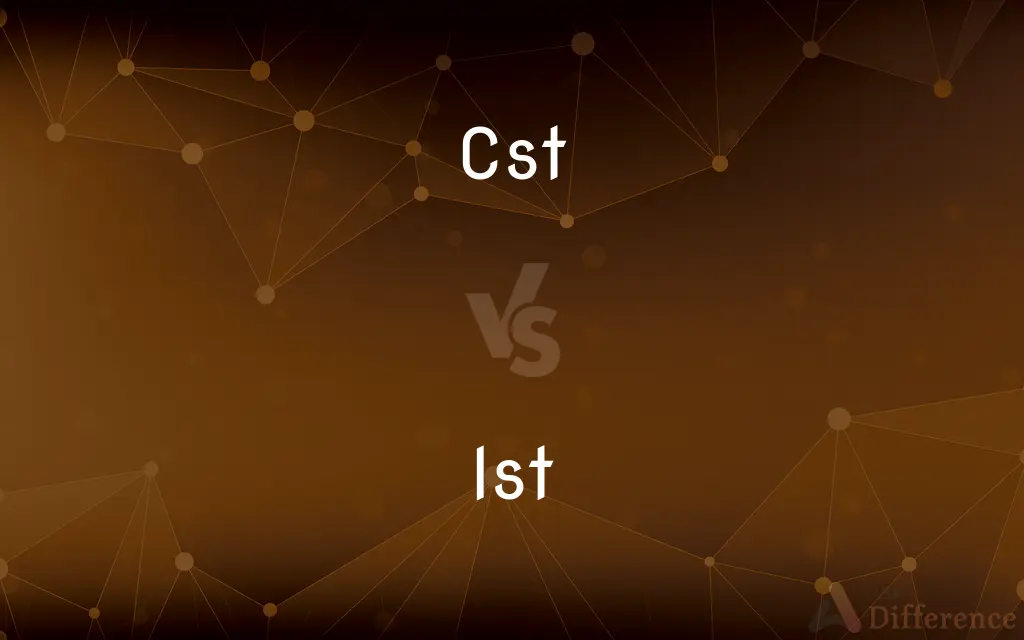CST vs. IST — What's the Difference?
Edited by Tayyaba Rehman — By Urooj Arif — Updated on April 15, 2024
CST (Central Standard Time) is 11.5 hours behind IST (Indian Standard Time), covering parts of the US and Canada, while IST remains constant for all of India.

Difference Between CST and IST
Table of Contents
ADVERTISEMENT
Key Differences
CST, or Central Standard Time, is a time zone used in parts of the United States, Canada, Mexico, Central America, and China, where it is typically 6 hours behind Coordinated Universal Time (UTC-6). Whereas, IST, or Indian Standard Time, is the time zone for India and Sri Lanka, consistently set at UTC+5:30.
In practice, CST switches to Central Daylight Time (CDT), which is UTC-5, during daylight saving time in locations such as the U.S. and parts of Canada. On the other hand, IST does not observe daylight saving time, remaining fixed throughout the year.
CST is utilized by a diverse range of countries across different continents, leading to a variety of cultures and practices operating within this time zone. Conversely, IST is specific to India and Sri Lanka, creating a more uniform timekeeping standard across these regions.
Major cities under CST include Chicago, Mexico City, and Winnipeg, which see significant changes in their daily routines when transitioning between standard time and daylight saving time. Meanwhile, major cities like New Delhi and Colombo under IST do not experience such shifts.
The usage of CST can cause confusion during the periods of switching between standard time and daylight saving time, affecting everything from business operations to travel. In contrast, IST’s non-changing nature provides consistency but can complicate coordination with regions that use daylight saving time.
ADVERTISEMENT
Comparison Chart
UTC Offset
UTC-6 (standard), UTC-5 (daylight saving)
UTC+5:30
Observes DST
Yes
No
Countries
USA, Canada, Mexico, etc.
India, Sri Lanka
Major Cities
Chicago, Mexico City, Winnipeg
New Delhi, Colombo
Daylight Saving Time
Switches in March, ends in November
No DST observed
Compare with Definitions
Cst
Time standard for central regions of Canada.
Winnipeg switches from CDT to CST in November.
Ist
The time standard across all of India, promoting unity in scheduling.
IST helps coordinate times across diverse Indian states.
Cst
The time zone of the central part of North America, six hours behind UTC.
When it's noon CST, it's 6 pm in London.
Ist
Also the time zone for Sri Lanka.
Colombo operates on the same time as New Delhi, despite being in a different country.
Cst
Standard time in the U.S. states between the Eastern and Mountain time zones.
Chicago operates on CST during the winter months.
Ist
The time zone observed throughout India and Sri Lanka, UTC+5:30.
IST does not change throughout the year.
Cst
Used during the winter months in areas observing daylight saving time.
CST reverts to CDT each spring.
Ist
Fixed time with no daylight saving adjustment.
Meetings scheduled on IST do not shift seasonally.
Cst
Also observed in parts of Central America.
Guatemala remains on CST throughout the year.
Ist
Central to operations in major Indian cities.
Mumbai’s stock exchange works strictly on IST.
Cst
Standard time in the 6th time zone west of Greenwich, reckoned at the 90th meridian; used in the central United States
Ist
A practitioner or supporter of an ism
Common Curiosities
What is the full form of CST and IST?
CST stands for Central Standard Time, and IST stands for Indian Standard Time.
How many hours is CST behind IST?
CST is generally 11.5 hours behind IST.
What countries use IST?
India and Sri Lanka use IST.
What countries use CST?
The United States, Canada, Mexico, and some Central American countries use CST.
Are there major cities that operate under CST?
Yes, major cities like Chicago, Mexico City, and Winnipeg operate under CST.
Are there major cities that operate under IST?
Yes, major cities like New Delhi and Colombo operate under IST.
Does the use of CST complicate international business?
Yes, the use of CST can complicate international business, especially during the transition periods of daylight saving time.
What is the geographical spread of CST?
CST covers parts of North America including central USA, Canada, and some regions in Central America.
Do CST and IST observe daylight saving time?
CST observes daylight saving time, switching to Central Daylight Time in the summer, whereas IST does not observe daylight saving time.
What is the geographical spread of IST?
IST covers the entirety of India and Sri Lanka.
How does the fixed nature of IST impact international coordination?
The fixed nature of IST simplifies timekeeping within India but can be challenging for coordination with countries that observe daylight saving time.
How does IST affect daily life in India?
IST provides consistency in timekeeping across India, affecting everything from daily schedules to national broadcasts.
How do businesses in CST adapt to changes in time due to daylight saving?
Businesses in CST adapt by adjusting work schedules, communication plans, and operational timings to align with daylight saving time changes.
Why does CST switch to daylight saving time?
CST switches to daylight saving time to make better use of daylight during the evenings in the summer.
Why does IST not change with seasons?
IST does not change with seasons because India is geographically positioned in a way that does not benefit significantly from daylight saving time.
Share Your Discovery

Previous Comparison
Ingestion vs. Digestion
Next Comparison
Buddhi vs. BuddhaAuthor Spotlight
Written by
Urooj ArifUrooj is a skilled content writer at Ask Difference, known for her exceptional ability to simplify complex topics into engaging and informative content. With a passion for research and a flair for clear, concise writing, she consistently delivers articles that resonate with our diverse audience.
Edited by
Tayyaba RehmanTayyaba Rehman is a distinguished writer, currently serving as a primary contributor to askdifference.com. As a researcher in semantics and etymology, Tayyaba's passion for the complexity of languages and their distinctions has found a perfect home on the platform. Tayyaba delves into the intricacies of language, distinguishing between commonly confused words and phrases, thereby providing clarity for readers worldwide.
















































